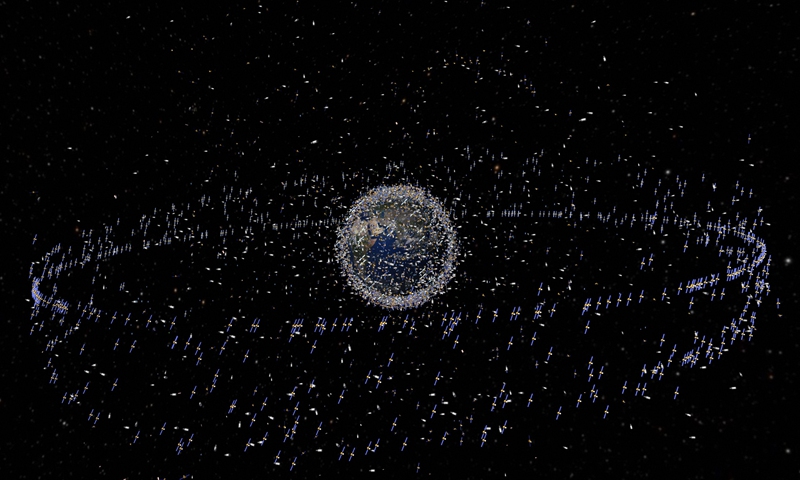
This file computer-generated image released by the European Space Agency (ESA) on April 15, 2008 shows trackable objects in orbit around Earth. File Photo: VCG
The Space Debris Monitoring and Application Center of the China National Space Administration sent out a warning on an extremely dangerous rendezvous on Tuesday between the Tsinghua Science satellite and Russia's Cosmos 1408 debris. An expert on space debris told the Global Times on Wednesday that the data released showed that there was a high chance of collision between the debris and the satellite on Tuesday.
"Currently, they keep a safe distance but the chance for these two getting close in the future cannot be excluded," Liu Jing, a space debris expert said.
The closest distance between Tsinghua's satellite and the Russian debris was 14.5 meters, with a relative speed of 5.27 kilometers per second. Liu told the Global Times that it is very rare to see the distance between space debris and spacecrafts within just a dozen of meters, as normally during the debris-spacecraft rendezvous, the two keep a distance of several tens of kilometers.
On Tuesday, when the space debris center calculated that the Russian Cosmos 1408 debris was very close to the Tsinghua Science satellite, researchers checked the previous observation data and found that the distance between the two objects was getting closer each time they complete an orbit. On Tuesday, the possibility of collision between the two became very high, which is alarmingly dangerous, Liu said.
Current calculations by countries of rendezvous of space objects have some errors. Considering those miscalculations and other factors, the international community usually takes evasive moves when the probability of collision reaches certain levels. "Regarding the probability of collision between the Russian debris and the Chinese satellite, theoretically, evasive moves need to be taken," Liu said.
However, the latest data show the distance between these two objects is increasing above five kilometers, which also lowered the chances of collision.
"But we cannot exclude the possibility that these two get closer in the future again," Liu said.
The debris came from a Russian anti-satellite test on November 15, 2021. Russia's anti-satellite test produced an estimated 1,600 pieces of debris larger than 10 centimeters, most of which were distributed in an orbital altitude range of 400 to 1,100 kilometers, according to media reports.
Experts said that China has launched hundreds of satellites within this orbital altitude. In theory, these space debris may pose a threat to China's spacecraft. Since Russia's anti-satellite tests last November, China has been closely monitoring the space debris created and calculated their locations daily based on the latest data to predict if there is a risk of collision between these debris and Chinese satellites, Liu said. He also highlighted that "if there is [a possibility of collision] we need to quickly notify our satellites and make some evasive maneuvers in advance to avoid these debris. This is the most feasible method at present."
Huang Zhicheng, an aerospace expert, said that as space debris has an increasingly frequent impact on human spaceflights, the tasks of reducing and removing space debris should be put on the corresponding agenda.
"It is not only necessary to conduct research on experimental devices or spacecraft to remove space debris, but also to formulate corresponding international laws and regulations on the generation of space debris under the framework of the UN," Huang said.
The US is among the major countries responsible for most space debris, and with increasing number of space activities, the management of space debris and space junk has become a global issue of concern and some cutting-edge aerospace technologies are being applied in this field. For example, the use of spacecrafts to capture space debris or the use of lasers to remove them. However, these have turned out to be difficult methods for debris removal.
"These technologies are still in the research stage and there is still some distance from practical application," Liu said.




